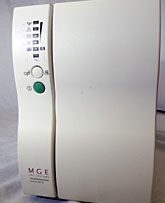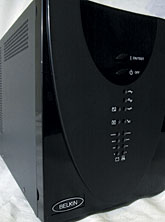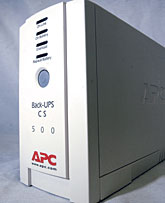Uninterruptible power systems in the last decade have matured from glorified car batteries to sophisticated cornerstones for network reliability.The GCN Lab took a look at six UPSes from five vendors. The primary criterion was long battery life. Other things being equal, 30 minutes of emergency power are better than 10.Another criterion was how well a UPS could blend into an existing network and an overall power management plan. The lab gave extra points if the software could effectively manage multiple vendors' UPSes, giving administrators more control over heterogeneous networks.The lab asked vendors to submit their UPS units rated at 1,000 volt-amperes. The VA specification is a measure of how many devices a UPS can effectively power without becoming overloaded.Most computers' power requirements are stated in watts, and that number multiplied by 1.4 gives the VA rating. For example, one of the test computers, a large workstation, drew 230 watts, which meant its VA rating was 322.Monitors sometimes state power in amps, which can be converted to VA by multiplying by 120.A 1.3-amp monitor would require a 156-VA UPS.If the total VA load of connected devices is less than the UPS rating, things will work properly. For example, a 1,000-VA UPS can support three average computers and a monitor, or two servers and a monitor.In tests, the lab connected three desktop computers and a monitor to the UPSes that met the 1,000-VA specification and had enough outlets. The total supported power demand of the test network was 866 VA'close to but less than the 1,000-VA maximum.Three of the UPSes were rack-mounted, including the from American Power Conversion. It occupied a 2U-space on a server rack and was the most difficult UPS to set up.American Power Conversion shipped it with the main battery disconnected. That's a good practice to keep the battery from accidentally discharging during transport.Another vendor's review unit did activate during transport and arrived at the lab with the low-power alarm beeping inside the box. In these days of high emphasis on security, a heavy package that's beeping will not be welcome, and might cause your mailroom to summon the bomb squad.The Smart-UPS 1000 design connected the battery to the front of the unit. That meant the main faceplate couldn't be attached for shipping, and because the main faceplate was off, the control faceplate couldn't be attached. The controls were left hanging from the front of the unit by a ribbon cable.Once assembled, however, the Smart-UPS beat all the competition except for the Tripp Lite UPS, which scored higher in a few categories.The Smart-UPS was the only one in the review with six outlets directly wired to the battery. Others had six outlets, but only five were protected by battery backup and the last one was surge-protected only.None of the other units in the review could touch the Smart-UPS in raw backup power. It kept the test network running for 46 minutes. Several of the others did not reach the 30-minute mark.With 46 minutes of power, users could pretty much work through a minor power outage without stopping. Even if they did have to stop, they would have more than enough time for an orderly shutdown.The Smart-UPS software, called the PowerChute Business Edition, could monitor a UPS, set up a server to manage a network of UPSes or monitor an existing UPS network.One disadvantage the lab encountered, however, was that the PowerChute software did not recognize other vendors' UPSes.That's no problem for networks with only American Power Conversion UPSes, but if you have a mix, you can't manage everything from one location. The Smart-UPS will automatically shut down all systems protected by American Power Conversion UPSes when battery drain becomes critical.Overall, the Smart-UPS earned high marks and a Reviewer's Choice designation.The lab would describe the Tripp Lite as versatile. It could be mounted in a rack where it takes up 2U, but it could also sit on the floor. The cooling intakes were recessed and would work even with the unit lying on a flat surface or standing up like a desktop tower on included plastic feet.The Tripp Lite also shone when it came to software, managing network UPSes regardless of brand. It would almost be worth buying just to get the management software. The only complaint was that, during installation, the system abruptly rebooted without an option to reboot later. Most installation programs allow time to close important files before forcing a reboot.The Tripp Lite UPS had six outlets, but one was only surge-protected. The device powered the test network for a respectable 36 minutes. It had a real sine wave power output scheme, so connected devices got a perfect power feed.Some UPSes simulate a real sine wave by using a forced electric pulse. That can cause line noise and hurt performance.The Tripp Lite UPS earned the second Reviewer's Choice designation for its strengths in supplying power and managing heterogeneous networked UPSes.The MGE UPS Systems , a floor-mounted unit, a smaller footprint than most of the other units, but its oblong box wouldn't fit in a rack.The unit seemed designed to protect one or two very important components. Despite its 1,000-VA load capability, it had only three outlets in back and thus would work best for power-hungry devices such as plasma monitors that draw 500 watts, or 700 VA. Because it couldn't connect all four test computers at once, the drain test was about 322 VA less than for the other units.The Pulsar supplied power for 32 minutes, even with a significantly lighter load.The MGE Solution-Pac software was by far the easiest in this review to use and learn. From the graphical interface, we could click on different network components to locate trouble spots such as high internal temperature or humidity. And Solution-Pac could set up automatic monitoring and shutdown of components under varying circumstances.The MGE UPS would work best for protecting mission-critical servers or components. Its only real negative was too few outlets. That would certainly tend to keep users from overloading it, but they would be paying for lots more VA capacity than they could effectively use with three outlets.The Belkin Components was another box-style UPS. It could not be mounted in a rack but took up very little footprint sitting on the floor. It was also comparatively inexpensive.Five outlets connected to the battery, and one outlet was surge-protected only. All were clearly marked.The Sentry Bulldog software that came with the unit could shut down systems during a power failure and perform other routine management functions. There were no bells and whistles, but the unit never failed to do its job and was easy to install and use.Its strength was in reliable power and surge protection for 21 minutes. At $449, it was the cheapest 1,000-VA unit in this review. For cheap power protection, consider the Regulator Pro NetUPS. The lab gave it the Bang for the Buck designation.The Para Systems was meant to be part of an overall network power solution, as was evident from the six outlets'five wired to the battery'and the unique network cable surge protection port. Running a network cable through the UPS would stop surges from traveling by that route.Many users don't realize that surges can come over network cabling, especially if there's a mess of spaghetti wiring, which is the case in most large network environments. In rare instances surges can even leap from one cable to another. This extra protection shows that Para Systems UPS designers understand all the types of power dangers for networks.The Sentry II power management and diagnostic software included with the unit was powerful but not easy to use. The lab had some trouble changing settings and defining power event priorities. Reading the 28-page manual in Adobe Portable Document Format was essential.As for controls, there was only one button on the front of the unit; everything else was software-controlled. The front button stuck out and was easy to push.The Enterprise 1100 was the one that arrived at the lab with alarm bells ringing, which made the delivery man very nervous.Where it fell behind the others was in time-to-failure testing.It lasted for the shortest time in the review'19 minutes'even though it had 100 VA greater load capacity than any other unit.American Power Conversion's , the smallest in this review and one of the smallest on the market, nevertheless packed a good punch at 500 VA. It had six outlets, three of them connected to the tiny battery. A surge protection outlet could accept a standard RJ-45 phone cable. In tests, the Back-UPS powered two computers and a monitor for seven minutes. It came with the same software as its big brother, the 1,000-VA unit.
Tripp Lite Smart OnLine 1000
Para Systems Enterprise E1100









